oldirish33
Member
"All Jaguars run on Guinness!"
Posts: 3,356
|
Post by oldirish33 on Jun 8, 2022 12:16:09 GMT -5
Two wonderful additions Jerry and both would be welcome here. I know it's sacrilege around here, but I never caught the Moss adoration bug. I know he was very talented and raced in a different time, but if he had gone to the right teams he would have won at least one world title, as other drivers of his and other generations did - I give you Juan Manuel Fangio your honour. Still, the Cooper is a gem and a nice part of the Moss story. I don't think I would call it sacrilege Martin, more of a good example of why I think its impossible to name the "best driver ever". There are too many factors involved and we all have our favorites for a variety of reasons. My son (who is 30) and I had this discussion while watching a recent F1 race. He asked me who was my favorite driver. I asked, in F1?, currently?, by era?, best sports car and prototype driver? most skilled?, most admired? Even though I told him my answer to the question could vary depending on how it was asked, he pressed wanting to know who I thought was the best of all time. I told him that I could only answer who I picked based on who had raced in my lifetime and even that was hard because while I may have been alive in the 1950's, my awareness of the drivers from that era came later in life. I told him it wasn't possible for me to compare pre-WWII drivers with those after the war because not only many of them lost prime years from racing because of war, but there is also a vacuum even today in race accounts and the level of history that one can find on post-war drivers. Not only did many lose prime years to the war, many did not make it to retirement from racing (same as 1950's and 60's.) So, I answered that Stirling Moss was my favorite driver of all time and here is why. Part of it is an emotional attachment. Stirling's face graced the box of a HO race set I got for Christmas in 1964. At that time I really did not know who he was and he had not been racing for over two years by then. Not really knowing who he was, the short bio that came with the set and a brief history lesson from my father helped fill in some of the blanks. That connection with the Christmas gift I cherished so much established a fondness for him that grew over time as I came to appreciate his talent and skill across a multitude of racing disciplines giving me the belief that of anyone, he was the best all round. If you use F1 as your yardstick, then yes he never did win the Championship, and Fangio holds the edge on number of overall wins and podiums as well. But you have to remember that Moss did not start in F1 at the same time and their F1 careers only overlapped three full seasons. Who knows what the comparison might have been had Moss started earlier, or Fangio later? Moss didn't drive for Ferrari, but he did drive for Maserati, Mercedes and Vanwall in F1. Moss lost the Championship in 1956 by only three points to Fangio and had Collins not unselfishly given up his car to Fangio (Musso had already refused) Moss would have been Champion. Moss was 2nd in the F1 points from 1955-58 and 3rd the following three seasons. In 1958 he lost the Championship to Hawthorn by 1 point, despite having more wins (4 to Hawthorn's 1) that season (remember Moss also defended Hawthorn against receiving a penalty that would have cost him the Championship.) His usually reliable (and dominant Vanwall) letting him down on two occasions cost him the Championship. I think when compared to his contemporaries he was on any given day the best in F1, just not lucky or fortunate enough to have won a title. I think another leg of the stool that has to be compared is how he did in sportscar and prototype racing (as well as rallying.) You have to remember that at the time, this was a much bigger deal than F1 in how F1 stacked up in motorsport. Not at the top like it is considered today. He likely would have won at Le Mans in 1955 if Mercedes had not withdrawn, but did finish second twice. His commanding wins at The Targa Florio, Mille Miglia, Tourist Trophy, Sebring, Reims and other major races showed his greatness behind the wheel. That greatness is backed up by the fact that he won over 40% of the 529 races he entered over a 14 year career, driving 84 different makes of cars in multiple classes. Those cars included some of the best in their day which included Jaguar, Maserati, Aston Martin, Mercedes Benz, even Ferrari. While staunchly loyal to his country, he preferred to dive British cars, but does say the biggest regret of his life was not driving a works Ferrari. Enzo apparently had the same regret, but stuck a fork in it when Moss was 20 and Enzo offered him a drive, only to take it away after Moss had travelled to Modena. While they patched things up 11 years later, and Moss was to drive a works Ferrari 156 F1 car in 1962 (in Rob Walker colors), along with a 250 GTO; Enzo's factory purge meant the Ferrari 156 wasn't ready when Moss had his career ending shunt at Goodwood in the fragile Lotus. Along with pondering the possibilities of what that union might have produced, what might his career beyond 1962 have been? It was obvious he was still on top of his game, being the only one to beat the works F1 Ferraris (twice) in 1961 in lesser machinery, as well as his dominance in the race described above against some of the sports best talent. Finally, I admire the man himself. Many see him as an arrogant, narcissisitic, playboy and dismiss him accordingly. While I know he was often direct, no nonsense, didn't often hold back opinions (qualities I have); he was also highly intelligent, organized and driven. At the same time he liked to have fun when he wasn't concentrated on work and if you read his books or articles written, interviews, etc., a great dry sense of humor. I recently reread the account by Denis Jenkison of their drive on the 1955 Mille Miglia. Jenks describes in great detail the concentration, reactions, conditioning and all other factors that went into driving a 1,000 miles in just over 10 hours almost non-stop, setting time and average speed records in the process. Jenks says that when one or both of them made an error., he didn't get mad, upset, or lose his concentration. He just stuck out his tongue, made a funny face and pressed on. A true mark of a champion for me. To me, he was and probably always will be the best all-round driver in my life time. That's my story and I'm sticking to it!  |
|
|
|
Post by reeft1 on Jun 8, 2022 13:12:51 GMT -5
A legend with an amazing ability to adapt to pretty much any machine. I admired him hugely.
|
|
|
|
Post by reeft1 on Jun 8, 2022 13:15:19 GMT -5
Two cracking cars there
|
|
|
|
Post by Tom on Jun 8, 2022 13:46:10 GMT -5
I have too little knowledge of his exploits to judge him, but he certainly seems to be the stuff heroes are made of. While excelling at one type of motorsport can make you a great driver, I think the true measure is how well someone does at multiple disciplines. If you can do well at GP racing, endurance and rallying, you're a great driver to me.
|
|
oldirish33
Member
"All Jaguars run on Guinness!"
Posts: 3,356
|
Post by oldirish33 on Jun 9, 2022 11:39:49 GMT -5
Two wonderful additions Jerry and both would be welcome here. I know it's sacrilege around here, but I never caught the Moss adoration bug. I know he was very talented and raced in a different time, but if he had gone to the right teams he would have won at least one world title, as other drivers of his and other generations did - I give you Juan Manuel Fangio your honour. Still, the Cooper is a gem and a nice part of the Moss story. This generation of F1 Surtees always brings back fond memories of my Matchbox 75 "Formula 5000" racer as it seems to be based on this car - I know that Matchbox had a relationship with Surtees in the '70s so that may have something to do with it. Sam Posey is one of those names that while being familiar, I don't know much about him. Although, a check of my database shows I have models of 4 of his cars! His name first came to my attention when he appeared at the Bathurst 1000 race in 1980, sharing a Chevrolet Camaro Z28 with local, Ron Dickson. They were any early retirement so I'm not sure if Posey actually got to race. Your collection is always interesting Jerry, and these two only add to the magic. Oh, and Tim Schenken went on to a long career in motorsport administration when he returned to Australia when his racing career was over. He only just retired as the V8 Supercars Race Director at the end of the 2021 season - he is 78 after all! Matchbox supported Surtees for a time. I'm not sure the sponsorship of race cars has paid huge dividends for the model makers that tried it (Matchbox. Politoys, John Day, AMR, etc.) That association though did result in some iconic models for their day. Sam Posey is probably much better known to American race fans and probably more some for his commentating than his racing. Indy 500 broadcasts are not anywhere near the same without his unique style and commentary. I'm hoping you think the next two additions bring more magic to the collection.  Great car and model, great back story! Thanks Tom! A legend with an amazing ability to adapt to pretty much any machine. I admired him hugely. Yes he was and in todays specialized racing world where there is no longer that easy cross-over by top tier drivers, a legend untouched? Glad you like them Paul, they are the warm up act for the next two.  I have too little knowledge of his exploits to judge him, but he certainly seems to be the stuff heroes are made of. While excelling at one type of motorsport can make you a great driver, I think the true measure is how well someone does at multiple disciplines. If you can do well at GP racing, endurance and rallying, you're a great driver to me. That is as good as any form of measure Tom. You might find some of the articles on line about Sir Stirling interesting reads. If nothing else, they provide a glimpse of what racing and driving was like in the 1950's. |
|
oldirish33
Member
"All Jaguars run on Guinness!"
Posts: 3,356
|
Post by oldirish33 on Jun 9, 2022 12:02:41 GMT -5
Remembering Wayne With Two For Jack - Continuing on our open wheel theme. Many on this forum probably don’t recognize the name Wayne Moyer, yet if you have been around the hobby any length of time, you have probably read one of his articles, or have seen pictures of some of his model builds. Before his passing in 2018, Wayne had authored over 2,000 printed articles and model reviews in 50 different publications. Mostly a 1/43 guy, he was also a prolific builder of model cars, but also plane and ship kits and his build quality was such that he was posthumously awarded Model Builder of the Year by the Model Car Hall of Fame. I knew of Wayne through his articles as we even did some trading together back in the 70’s when in pre-internet days, buying, selling and trading was done by mail and by phone. These two cars were driven by another of my heroes, Jack Brabham and both cars have unique history. Both were built by Wayne and were part of his collection (may have been subjects of reviews). Both are SMTS kits and I’m sure Wayne’s build quality is as good, if not better than a factory-built model. They came up at auction and I bid assuming I would not win. To my surprise, there were no other serious bids (don’t have an auction end on a holiday weekend!) and I ended up with both of these models for about the same as a new IXO. Even though I didn’t need another Brabham BT19, I’m glad I bid!  Cooper T54 - 1961 Indianapolis 500, Jack Brabham - SMTS Cooper T54 - 1961 Indianapolis 500, Jack Brabham - SMTSJack Brabham was the reigning two-time World Drivers Champion in 1961, when he came to Indianapolis in 500 to take his rookie drivers test. 1959 Indy 500 winner Rodger Ward persuaded John Cooper that one of his cars which had been dominating F1, could do well at Indy. In turn Cooper built the T54 expressly for running the 50th Anniversary Indy 500 in 1961. The car had a longer, wider chassis than the T53 F1 car and it was powered by a 2.7L Coventry-Climax engine producing 268 bhp. The larger Indy roadsters were producing 430 bhp with their 4.4L engines, but the Cooper was lighter and handled in the corners better. Brabham qualified 17th at 145.144 MPH, the pole setter at 147.481. 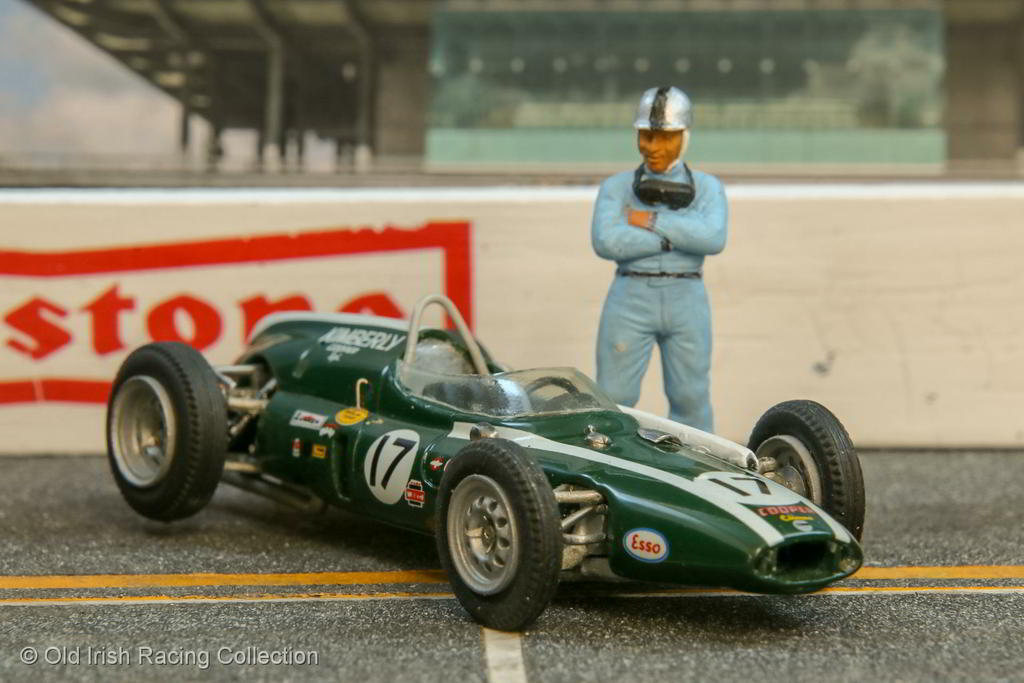 The Cooper was sponsored by Jack Kimberly whose paper company produced Kleenex. The team’s strategy at Indy was for Brabham to drive a conservative race using the cars weight and fuel consumption advantage to only make two scheduled pit stops. Unfortunately, the Dunlop tires developed for the race did not wear as well as expected and Brabham was forced to make a unplanned third stop after running as high as 3rd place. It is speculated that if he had been more aggressive and planned a third stop for tires, he would have placed higher than 9th. What is certain, is that the T54 pointed the way forward and that rear-engined cars were the wave of the future. 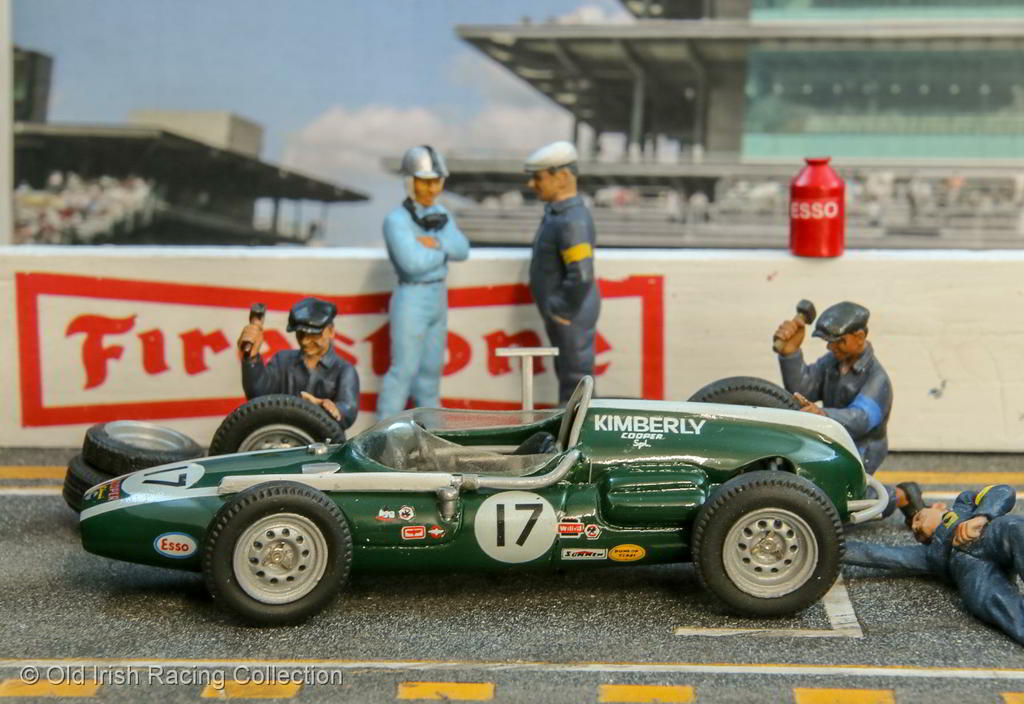 Brabham BT19 “Old Nail” - 1966 French GP, Jack Brabham Brabham BT19 “Old Nail” - 1966 French GP, Jack BrabhamThe 3rd race on the 1966 F1 calendar, the French GP of 1966 marked the 60th Anniversary of the first ever grand prix race, the French Grand Prix of 1906 held near Le Mans. It was also to be the last French GP and last championship race held at the old Reims circuit. Jack Brabham was driving his then new BT19 which would take him not only to the win at the French GP, but victory in the next three GPs and two other podiums as well. The Old Nail as Brabham called it helped make the 1966 season a highlight for Brabhams career, giving him not only the World Drivers Championship, but the Constructors Championship as well. 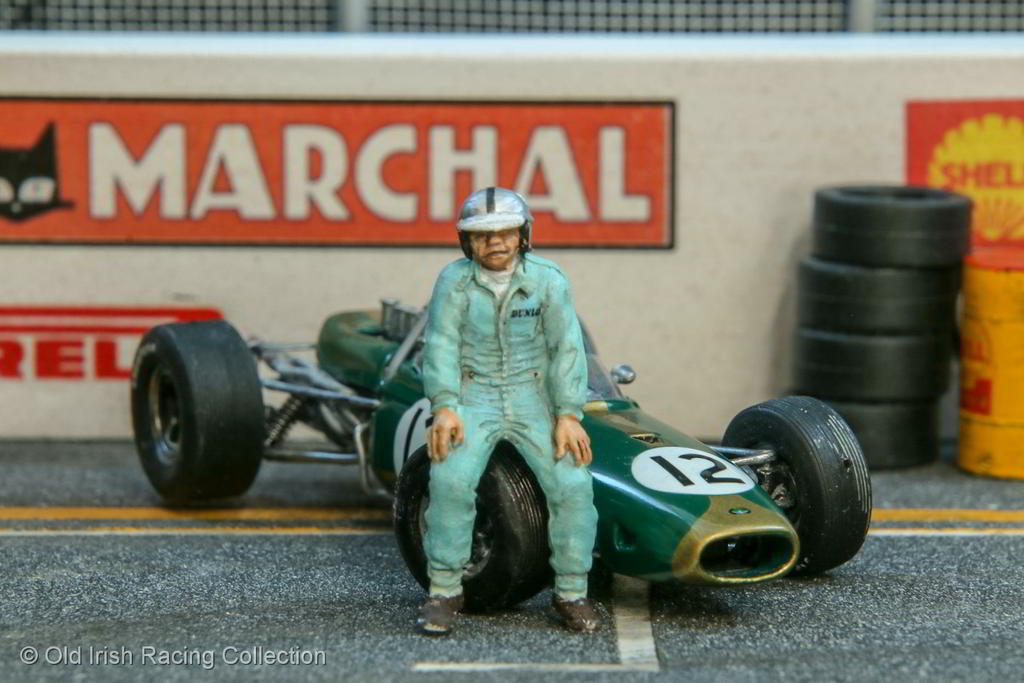 Post Scripts Post Scripts – Wayne Moyer developed a reputation for his model reviews in Four Small Wheels, Scale Auto Modeler, Diecast X and other publications. By the early 1970s he had established such a writing reputation, that along with his building skills, makers of white metal kits sent him kits to hopefully build and review. Its likely that is where the SMTS kits came from. Why Wayne painted the Cooper green rather than its correct blue isn’t certain. My guess is that in the days before the internet information was scarce and since the works F1 cars were green, he assumed that to be the correct color. The book pictured in the first image is a title still available new on Amazon. If you want to get a history lesson on the early pioneers of the hobby who produced the first white metal kits, this is a great read. In large part, you have this man to thank for the continued development and detail makers put into their white metal and later resin kits. Because of his reviews, they continuously tried harder. That has ultimately led to the level of detail and availability of resin models today. One tragic thing about our hobby is that a great deal of its history has been lost, or at best is widely scattered. If you want an appreciation for how the resin models we so revere today came about, read this book! 
|
|
|
|
Post by reeft1 on Jun 9, 2022 12:28:48 GMT -5
Those are two cracking kit builds
|
|
|
|
Post by JSB33 on Jun 10, 2022 6:55:42 GMT -5
Super adds, Jerry. Almost impossible to be in the US and not know Wayne Moyer.
|
|
|
|
Post by Tom on Jun 10, 2022 11:12:01 GMT -5
Those really have an aura that no modern mass-produced state-of-the-art model has. Excellent adds and proper bargains too!
|
|
|
|
Post by Alfaholic on Jun 11, 2022 0:03:01 GMT -5
Jack Brabham - a driver I can get on board with  - there's that emotional thing coming out! Another couple of stunners Jerry. |
|
oldirish33
Member
"All Jaguars run on Guinness!"
Posts: 3,356
|
Post by oldirish33 on Jun 12, 2022 1:01:18 GMT -5
Those are two cracking kit builds Wayne was a top notch builder for certain. Super adds, Jerry. Almost impossible to be in the US and not know Wayne Moyer. I wish he had done more compilation of his work on the history of diecast. Those really have an aura that no modern mass-produced state-of-the-art model has. Excellent adds and proper bargains too! Thanks Tom! It's one of the main elements that draws me to these old hand built white metal models. Jack Brabham - a driver I can get on board with  - there's that emotional thing coming out! Another couple of stunners Jerry. Thanks Martin! I can't envision how anyone could not like Jack Brabham. |
|
|
|
Post by jager on Jun 12, 2022 2:44:38 GMT -5
Very cool additions Jerry. I recently came a cross a magazine article on SMTS and despite being a model maker of global renown, I was surprised to see they worked out of a very simple and relatively small industrial unit. It's amazing what they achieved from such humble arrangements.
|
|
oldirish33
Member
"All Jaguars run on Guinness!"
Posts: 3,356
|
Post by oldirish33 on Jun 12, 2022 8:40:33 GMT -5
Very cool additions Jerry. I recently came a cross a magazine article on SMTS and despite being a model maker of global renown, I was surprised to see they worked out of a very simple and relatively small industrial unit. It's amazing what they achieved from such humble arrangements. Thanks Ian! I think they retained much of that cottage industry feel. Now that they have been purchased by the firm/ individual that owns Brooklin, it will be interesting to see what happens. I'm hoping that maybe some of their models only available as kits will once again become more plentiful as factory builds. |
|
oldirish33
Member
"All Jaguars run on Guinness!"
Posts: 3,356
|
Post by oldirish33 on Jun 12, 2022 10:00:19 GMT -5
High Class Bugs - Had I been born a decade or so earlier, I could see myself owning a Bugatti or two. Unfortunately, by the time I really came to appreciate Bugatti's for the engineering and design marvels that they are, their prices for even an unrestored example were stratospheric for my means. So, I have lived that interest vicariously through nice examples of Bugatti models such as the two presented here. The Type 57, as with most enthusiasts, holds the most interest for me. Its interesting to ponder had Jean Bugatti lived past 1939 and survived the war; would Bugatti have been able to resurrect itself into a viable company again after WWII and have become a boutique luxury automaker like Ferrari? Perhaps if they did, some of their cars like the T57 may have stayed "affordable" a little longer. 1935 Bugatti Type 57 Ventoux - Heco
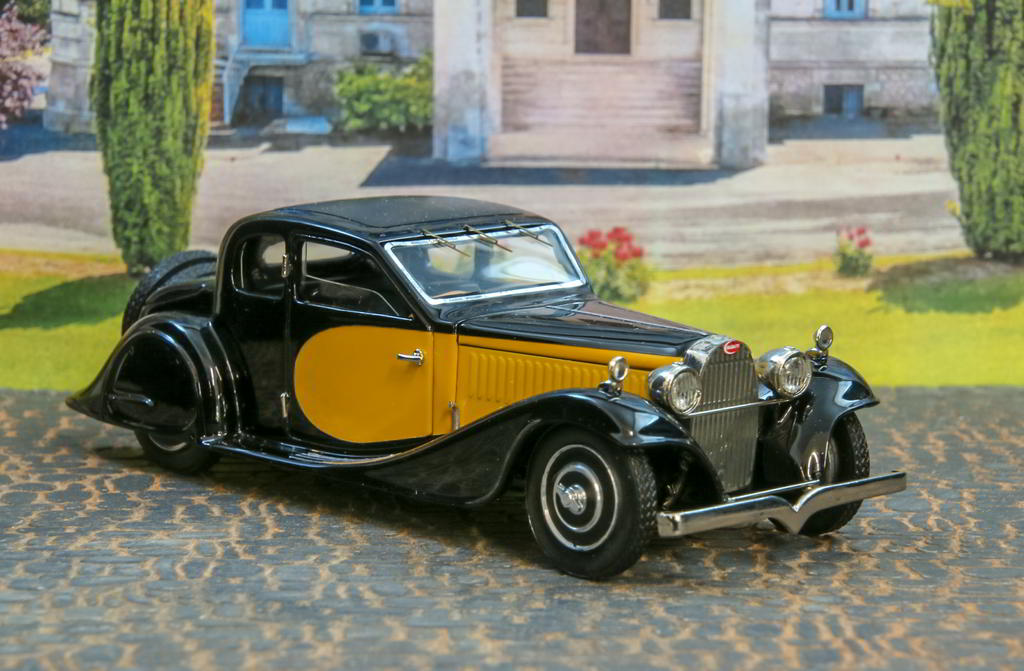 The Bugatti Type 57 (T57) was produced from 1934 to 1940 and the cars were a beautiful incorporation of Jean Bugattis designs and Ettore Bugattis masterful engineering. The father and son created some o the most beautiful as well as powerful pre-WWII motorcars. The Type 57 of which 710 cars in the different T57 variants were built.  A grand touring car, the Type 57 (T57) has a DOHC 3.3L straight-eight engine whose 135 HP engine could propel the one-ton car at a top speed of 95 MPH. This T57 (Ch. #57107) is a fairly early production car in striking Ventoux four-seat coupe bodywork, one of two body styles available , a four or two window coupe. This car is a four window coupe. The name Ventoux comes from one of the peaks in the French Alps and is a Jean Bugatti designed body built in-house at Bugatti. Approximately 139 Ventoux bodied T57s were produced.  1938 Bugatti Type 57C Aravis Coupe by Gangloff - Ilario-Chromes 1938 Bugatti Type 57C Aravis Coupe by Gangloff - Ilario-Chromes

In 1936, The Type 57 (T57) was revised to incorporate a competition inspired chassis which allowed the cars to sit lower. For production in 1937, a Roots-type supercharger was fit to the DOHC 3.3L straight-eight engine, which increased the horsepower over un-supercharged cars by 25 HP to 160 HP and the top end speed from 95 to 120 MPH. Considering the average top speed for luxury cars at the time was about 85 MPH, the Bugatti was not only beautiful, but a high-performance car to boot! Bugatti offered a variety of choices in body styles based on the T57. There were coupes and cabriolets with bodies produced in-house (Ventoux, Stelvio, Galibier) but one could also have custom bodied coachwork built to Bugatti designs by noted coachbuilders at the time. 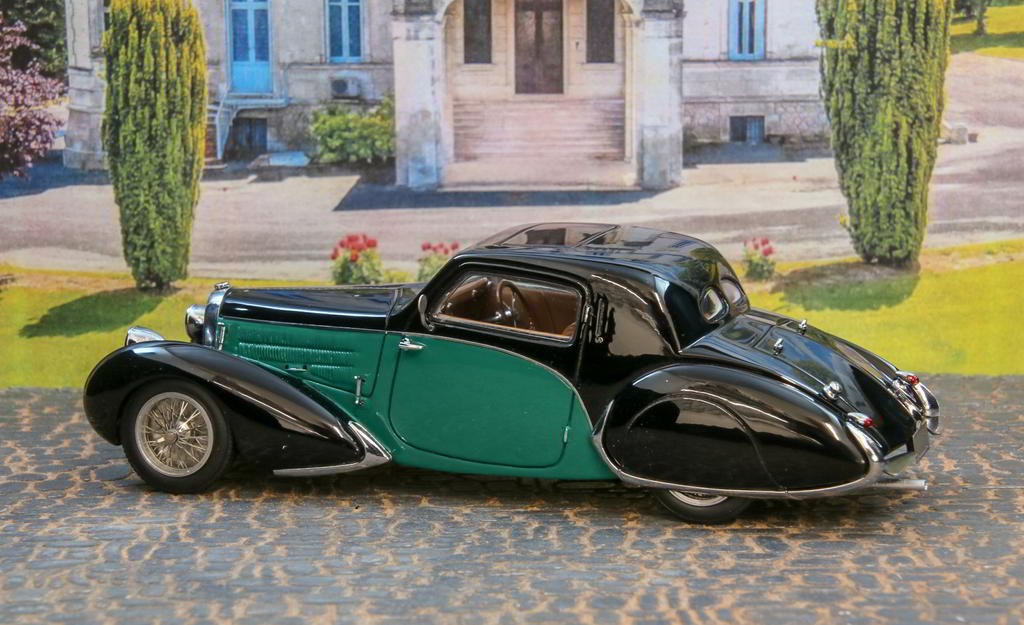 One such coachbuilder for Bugatti was Gangloff, then one of the most important coachbuilders before WWII. The Swiss firm bodied many luxury cars, but Bugatti was an important source of work. Keeping with the practice of naming the Type 57 (T57) body styles after French Alp peaks, the Aravis built by Gangloff (often just T57 Gangloff) was a striking two-seat coupe introduced in 1937. Like all Bugattis for 1938, it received hydraulic brakes rather than Ettore Bugattis preferred cable brakes. Less than 100 of these coupes were made up to 1940 and while somewhat overlooked when compared to its sisters the Type 57 S and SC. Less than 100 of these coupes were made (this car is Ch#57717.) 
|
|
|
|
Post by Tom on Jun 12, 2022 10:22:50 GMT -5
Two fantastic models! I prefer the first one with disc wheels as opposed to the wire wheels in the picture, looks much cleaner.
|
|





 - there's that emotional thing coming out!
- there's that emotional thing coming out! - there's that emotional thing coming out!
- there's that emotional thing coming out!
